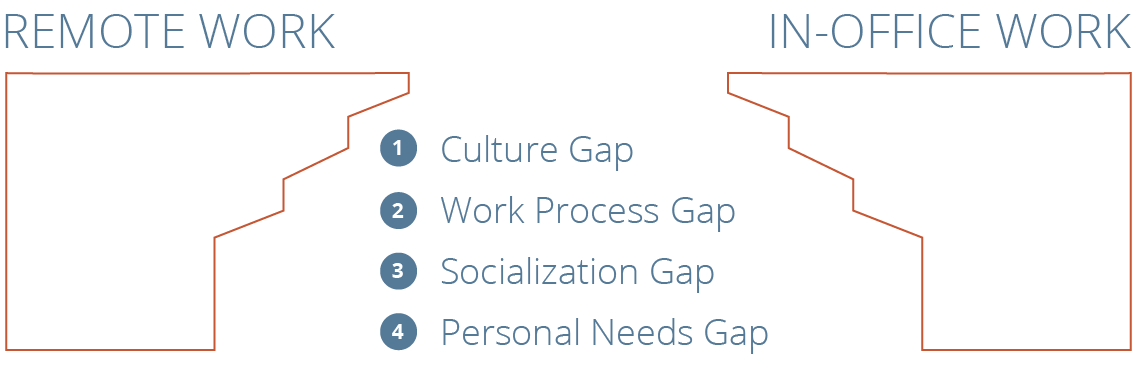The Future of Hybrid Work: Overcoming Challenges, Capitalizing on Opportunities
As COVID-19 restrictions recede, companies face the task of redesigning organizational and individual work arrangements to accommodate those who do not want to give up working from home and others who are eager to return to the office. A large swath of the workforce, however, will be somewhere in the middle, preferring to mix and match the benefits of remote work and physical offices.
Best of Both Worlds
A recent Microsoft report highlights the balancing act that companies face: The results of the study show that 70% of employees want to continue working remotely while 65% of employees desire to work in-person with their teams1. This presents an opportunity for companies to reimagine the future of work as a hybrid of remote and in-office arrangements.
% of employees who want to continue working remotely
% of employees desire to work in-person with their team
To meet employees’ desire for flexibility, companies will need to bridge gaps in culture, work process, socialization and personal needs to enhance both remote work as well as in-office arrangements (see Figure 1).
Figure 1

Closing the Gaps in Remote Work Arrangements
1. The Culture Gap
One trap in attempting to maintain culture and employee harmony is the “in-group” versus “out-group” syndrome. If one group of employees chooses to come into the office on a more regular basis and another chooses to work from home, the organization runs a higher risk of this schism – with those working together in the office exchanging information that the “out-group” may not be privy to. One way to mitigate the culture gap with remote employees is to rotate who comes to the office and who works from home. Preventing cliques from forming may mean having in-office employees attend team or group meetings online from their workspaces rather than as a group in a meeting room.
2. The Work Process Gap
Employees’ fear of missing out when not in an office is genuine, so work should be visible and transparent for both in-office and remote employees. If a remote employee is part of a team or group, managers must ensure that work being done in the physical offices is clearly defined and available for them to see. Short meetings to synchronize the work can also facilitate more work transparency.
In a team meeting where both remote and in-office employees are present, the meeting facilitator (a role that can be rotated among team members) should ensure achievements of both virtual and in-office employees are highlighted. Identifying issues to be addressed – delay in one’s output that is affecting others’ work, for example – should be another key aspect of the meetings. Working remotely does not equate to all-hands-on-deck Zoom meetings throughout the day. Desynchronizing work into components that can be accomplished by individuals separately before synchronizing to resolve work conflicts may be the antidote to Zoom fatigue. Blocking out time for asynchronous work should be encouraged and respected.
3. The Socialization Gap
Separate time for socialization and bonding is as important (if not more so) for employees working remotely as for those in the office. To mitigate the risk of a gap, arrange for socialization at the team level, whereby a virtual meeting is dedicated specifically to team-building events.
Outside of exclusive socialization and bonding activities, every work meeting should devote five to 10 minutes to socialization and resocialization. Team members should be encouraged to speak about what is on their minds and what is going on in their lives. Starting with those who are virtual will ensure their voices are heard and signal that they are as important as those who are on-site. Managers can increase social connectedness by scheduling individual check-ins with team members who are primarily working from home.
4. The Personal Needs Gap
Employees often assume that they need to be in the office to be promoted and rewarded.2 To avoid this gap, organizations need to relate performance to objective measures linked to output. Leaders should also ensure that remote employees are treated equally compared with in-office employees.3
The other concern is that a remote employee may be missing out on a crucial mentorship opportunity by not going into an office. To mitigate this gap, managers should provide mentorship opportunities to those who are virtual. Leaders should proactively have conversations with remote employees, while also providing open-door office hours for those on-site.
Breaks and other personal considerations of remote employees need to be accommodated positively. One way to address this is through managerial guidance and encouragement. For example, virtual employees can be empowered to block off time on their calendars to meet their personal needs.
In physical workspaces, four gaps must be addressed in reimagining the role of the workspace, which will be essential as hybrid work becomes the new normal for many organizations.
Closing the Gaps for In-Office Work Arrangements
1. The Culture Gap
Physical offices will take on new purposes in the post-pandemic world. One will be the physical manifestation of the culture of the organization. While being remote, we have realized that it is workplace culture that is missing in daily routines. Sharing physical space allowed us to see and emulate the actions of others and gather to recognize achievements and accomplishments.
In office, employees can hear about the workplace culture from senior executives, learn how to exemplify the culture and recognize those who have demonstrated it. Of course, this could also be a webcast to remote employees so that they hear the culture message and see it rewarded.
Live learning events, such as talks and demonstrations, may also be a great use of office spaces to reinforce culture packaged with extending skills. For example, a whole week may be devoted to a thematic learning experience, with the same talks and demonstrations being repeated, so that employees – when they choose to come in on a rotating basis – may get the opportunity for similar learning experiences. These experiences and events may also be livestreamed.
2. The Work Process Gap
A subtle but critical reason why employees like being in office is to hear others’ ideas and be inspired to think creatively. Watercoolers and break rooms have long been the places where social talk can lead to a collision of ideas that provides the spark for innovation. When reimagining the workplace, it is this collision of ideas that may have to be systematically designed into the space.
On occasions when the entire team chooses or is encouraged to come in at the same time, physical spaces can be used for team-building exercises.
3. The Socialization Gap
If there is one thing we have learned during the pandemic, it is that we are humans with a need for being with others. Offices should be designed to encourage the moments of being together.
Workplaces are much more than places to work. The design of physical workspaces can drive more mindful work, better socialization and overall employee satisfaction.
Open-air spaces may be used for “around the campfire” activities to share and learn about one another outside of work. Deliberate activities focused on sharing one another’s lives may go a long way in reinforcing the culture and helping employees to be cognizant of constraints and situations others face.
4. The Personal Needs Gap
Despite the flexibility and convenience of working from home, some employees still want to feel as if they are going to a physical location of work. A change of location can often prompt a work mindset, and physical work environments can be designed to give employees spaces to be more thoughtful and creative about their work. Getting away from home may also allow employees to restore some work-life balance.
The design of the workplace will go hand in hand with this. Cubicles of the past may be less important than the open spaces in the office building. Monolithic office campuses, buildings or floors may give way to satellite offices where groups and teams who are most closely tied to the performance of work can come together on chosen times and days.
Working in a Post-Pandemic World
In a post-pandemic world, we must create an environment where the work design is more mindful and cognizant of employees’ mental health.
Hybrid work arrangements are here to stay, and the location of work is increasingly the choice of the employee. To attract talent, companies will need to not only accommodate an employee’s choice but also enhance the experience and productivity of that choice, whether it’s working remotely or in an office.
This is a condensed version of the research brief Managing Hybrid Work by authors Arvind Malhotra and Claudia Kubowicz Malhotra. Access the full version.
1 Microsoft. (2021, March 22). 2021 Work Trend Index: The Next Great Disruption is Hybrid Work – Are We Ready?. www.microsoft.com/en-us/worklab/work-trend-index/hybrid-work.
2 Mortensen, M. & Haas, M. (2021, February). Making the Hybrid Workplace Fair. Harvard Business Review. https://hbr.org/2021/02/making-the-hybrid-workplace-fair.
3 Grimstead, S. (2021, April 27). How to Make the Hybrid Workplace Fair for All. Fast Company. www.fastcompany.com/90627909/how-to-make-the-hybrid-workplace-fair-for-all

